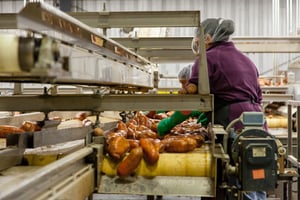If you’re moving product – especially fine or powdered bulk materials – chances are that you are creating a dust issue within your plant. From belt and screw conveyors to bucket elevators and scale hoppers, moving materials almost always generates some level of dust and fine particulate. This dust can lead to a number of issues, including: 
- Product and environmental contamination
- Increased maintenance needs and faster equipment wear
- Regulatory penalties
- Increased dust explosion risk
In addition to the above, conveyor dust can be a major danger to worker safety, as inhaled dust can irritate bronchial airways and exacerbate existing respiratory conditions. If this dust makes it to nearby residential areas and businesses, complaints can endanger your future operating permits.
That’s why managing conveyor dust, known in the industry as fugitive dust, is a top priority for bulk material handling operations. Here at Sly, with nearly 150 years of experience managing dust in industrial applications, our experts know how to safely keep your products, and your business, moving forward.
What is Fugitive Dust?
Fugitive dust, or nuisance dust, is the dust that is generated while moving materials. This differentiates fugitive dust from process dust, which is created from grinding, screening or drying materials.
While most any activity that disturbs bulk material is going to generate fugitive dust, crushed, fine and powdered materials are the biggest culprits. Examples of materials known for generating fugitive dust include:
- Grains and flours
- Cannabis
- Mined aggregate and minerals
- Salt and spices
Industrial conveyors are a major source of fugitive dust since they often move large amounts of material at high speeds. Unless properly designed with a perfect seal and installed correctly, drop chutes, impact points and conveyor enclosures are all places where fugitive dust can become a problem.
How Do I Properly Handle Fugitive Dust?
When dealing with fugitive dust, one idea may be to try and simply clean up any dust that escapes from your conveyors and transfer points. However, not only does this approach fail to address the root of the problem, but it is also time-consuming, costly and potentially dangerous.
Placing the burden all on your cleaning crew will quickly drive up your operational costs through the increased maintenance and operator time required to dispose of fugitive dust. Not only that, but this places your staff near moving conveyors and other dangerous process equipment, increasing the risk of an injury.
Trying to clean away the problem can also cause clouds of pollutants to form as you agitate the dust and send it into the air. If this dust is combustible, it will create clouds of explosive dust that put you at further risk for a dust explosion.
Instead of going the cleaning route, you’ll want to handle your fugitive dust issue directly, preventing it from ever even spreading throughout your facility. This can be done with quality dust collection equipment.
By installing a dust collector directly at the source, you can collect fugitive dust and dispose of it before it ever becomes a problem. Depending on the application and desired product purity, you may also be able to recycle the dust back into your system, minimizing product loss.
Baghouses and Cartridge Collectors
If you are looking to handle fugitive dust reliably and efficiently, baghouses and cartridge collectors are tried and true means of dry dust control.
Used in a variety of applications, Sly’s TubeJet® baghouse dust collectors offer on-line cleaning with a steady pressure drop and “no tools required” bag changes. Sly’s square series pulse jet collectors and cylindrical collectors offer a full range of baghouse designs and media choices to solve even the toughest conveying applications.
When dealing with dry and free flowing fugitive dust, Sly’s PleatJet™ cartridge dust collectors are an ideal choice for controlling dust emissions. Sly offers two types of cartridge filters: the PleatJet™ vertical cartridge collector and the PleatJet II™ horizontal cartridge collector.
For more remote transfer applications, a bin vent installed on the transfer point may be right for you. These smaller collectors don’t have a hopper and can help minimize collector space requirements and operational costs when collection needs aren’t as high.
Wet Scrubbers
By using a scrubbing liquid instead of a filter bag or cartridge, wet scrubbers can remove a variety of contaminants through the impingement process. Wet scrubbers offer the perfect dust management solution for many bulk material handling applications, especially those with:
- Light dust loadings
- Wet or sticky particulate
- Humid air or combustible dust
The efficiency of your wet scrubber is directly controlled by the size of your water droplets. Sly’s Venturi/Impinjet® combination scrubber can remove pollutants from stack emissions with a 99.9% efficiency rating.
The Sly Solution to Better Conveyor Dust Management
When it comes to handling industrial dust, Sly offers a mix of high-quality dust collection equipment and operational expertise to help give you the cleanest systems possible.
We don’t just give you a standard dust collector – we analyze your systems and your unique needs to specify the perfect air quality control equipment for the job at hand. For instance, you might need a collector with stainless steel construction to avoid contamination from the collector when recycling material. Since fugitive dust particles are generally larger than process dust particles, we can also help you design a collector with air-to-cloth ratios that are efficient and cost effective.




